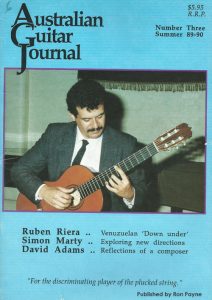
Teaching Skills and Strategies
By Isolde Schaupp
It is not sufficient to be competent in a subject if one wants to teach it. Successful teaching requires, in addition, a systematic approach to the subject to be taught, as well as general teaching skills and strategies. Students need to be stimulated, motivated and helped to acquire the necessary knowledge and develop the requisite skills in the area concerned. This applies to all teaching, including, the teaching of a musical instrument like the guitar.
Share this:
[feather_share]
PROCEED STEP-BY-STEP FROM THE KNOWN TO THE UNKNOWN
It is an accepted principle of pedagogy to build on previously acquired knowledge and skills when something new is introduced. In this way, extension is allied with reinforcement. The new step should however, always be clearly perceivable by the student. In the teaching of an instrument this principle needs to be equally applied to the musical as well as the technical development. Unfortunately, very often only the acquisition of technical skills is the focal point of concern, and pieces are chosen which are far too difficult from a musical point of view. A teacher should ensure that neither area is neglected. Nor should a student be overtaxed in one of these areas. While integrating both areas, progress should be geared, to the individual pace and ability of the student. Only a successful student remains motivated.
APPLY THE QUESTIONING TECHNIQUE
The practical work within a lesson is always guided by verbal communication. The study of an instrument cannot be effective if there is only practical demonstration and intuitive imitation. Any practical work needs to be based on a well-founded analytical understanding so that the student does not merely reproduce but learns to know what he/she is doing and why. However, this does not necessarily mean that intellectual understanding must always precede a practical effort. It might well be vice versa.
The use of the questioning technique is a well- known methodological device in school-teaching and is also highly recommended in the teaching of an instrument. A series of well-directed questions serves to encourage the analytical and creative thinking of students. In other words, students are stimulated to find their own solutions to the tasks and problems with which the teacher confronts them. This may be more time consuming than simply lecturing to the student, but in this way the teacher ensures that the student remains active and eventually achieves understanding at much greater depth. Knowledge which is acquired through active thinking sinks in much better than knowledge which is merely transmitted verbally. Younger children, in particular, tend to “switch off’ if they are not continually activated. The questioning technique is a good way to ensure their attention. It also gives the students a sense of achievement when they find the answers themselves. This has a very positive effect on their motivation.
USE APPROPRIATE LANGUAGE
Teachers should always try to ad just their language – that is, the speed and level of their speech – in accordance with a particular student’s age, background and ability to comprehend. One must be aware that students do not necessarily indicate if they do not understand what has been said. They sometimes only pretend to understand to avoid appearing unintelligent. It is therefore important that teachers observe students reactions and reassure themselves through questioning that explanations have been fully understood. Teachers should blame themselves rather than the student, if there is a communication problem. It is their responsibility to make themselves understood.
WORK WITH ASSOCIATIVE IMAGINATION
While the achievement of rational understanding of technical actions and musical structures is an important aim, it must be appreciated that associative pictures and images also fulfill a vital function. They can greatly assist in the execution of certain movements and musical shapes since they stimulate directly the need motorial and emotional responses. Especially young children can relate to images much better than to abstract descriptions (e.g. “surprise the string when striking” would be understood much more easily by certain students than “strike with a sudden action”; “imagine your guitar is singing very softly” rather than “play pp with a well-rounded tone”). Although associative pictures should not replace rational understanding, they might help a student in the first instance to execute a new movement correctly before an effort is made to understand it analytically. Teachers should try to find such pictures in their own associative imagination and use them whenever indicated on all levels, especially in connection with musical expression.
ENSURE ADEQUATE REINFORCEMENT OF NEWLY ACQUIRED SKILLS
Forgetting starts immediately after information is taken in – what has been newly learned during a lesson is likely to be partially or totally forgotten very rapidly. This can only be prevented by immediate reinforcement of newly acquired skills within a given lesson. Teachers should never forget to demand an adequate number of practical repetitions, as well as seeking verbal reinforcement. Teachers should make a habit of summarizing at the end of a lesson, preferably in the form of questioning what the student is expected to remember.
CHOOSE APPEALING PLAYING MATERIAL
Only a motivated student works. Interest in the playing material is usually the main reason for a student to practice. Dry exercises are then more readily accepted, particularly if they result as a necessity from the work on an attractive piece. Pieces appeal to students for different reasons, mainly because they are either in a style of music they like to listen to, or because they promise maximum effect with minimum effort, or because they suit the particular level of musical and technical ability etc. Beginners are usually open to all suggestions and a teacher can, of course, influence a student’s taste. Nevertheless, a teacher should always carefully consider the selection of pieces and give students a choice between several pieces, to find out which one appeals most. Naturally, musical technical aims must not be lost sight of. Many pieces can serve the same purpose. It is therefore important to build up a large pool from which teaching pieces can be drawn.
Sometimes students are obsessed with wanting to play a certain piece even if it is beyond their reach. It is wise in such cases to agree to work on it rather than to refuse, as the student would probably practice the piece anyhow and would play it even more unacceptably. Eventually the piece will lose its attraction when the student, working under guidance, experiences his/her limits in improving it. A teacher should be prepared for such compromises in order to keep up a student’s enthusiasm.
KNOW HOW TO CHANGE TASKS
Teachers must make an effort to change tasks during a lesson frequently enough to avoid the student becoming bored. It is for example better to come back to the same problem after turning temporarily to something different rather than spending too much time on it uninterruptedly. Alternatively, a given problem can be resolved by tackling it with different material. Teachers should try to be inventive in this regard. New tasks always represent new challenges and make work more interesting. The same applies to the weekly homework. Students generally do not like to practice the same material for too long even though perseverance may vary a great deal. Teachers should check this out in each individual case and adjust their teaching style to the individual person.
TEACH STUDENTS HOW TO WORK AT HOME
It is essential that students learn from the very first lesson how to practice, as their progress will depend on the quality of their homework. To ensure that quality comes before quantity teachers should not include too many tasks in one block of homework. And, rather than giving only general directions, time should be spent during the lesson to actually practice examples with the student, in order to demonstrate the practical application of important practice principles.
In connection with this, detailed instructions should be given, relating to the particular homework, e.g. on how, how long, and in which order the student should work on each item, how often a passage or exercise should be repeated, etc., until a student gradually develops certain working habits and strategies and eventually becomes more and more independent in the planning of each practice session. Teachers should realize that this can take quite some time and patiently adjust their demands to the talent, stage of development and perseverance of each student.
ENSURE ADEQUATE FEEDBACK
The feedback one receives from others regarding one’s activity is always important. In extreme cases it may make the difference between continuing with enthusiasm or stopping altogether. Encouragement may stimulate a student to special efforts while discouragement may produce frustration. This applies to the playing of an instrument as well. Both praise and constructive criticism are necessary to encourage students to keep working, while an indifferent response by the teacher can be most discouraging. Teachers should be aware of the importance of their reactions in relation to a student’s efforts and achievements and try to control them. Generally, praise is the greatest form of encouragement and we should therefore never forget to mention clearly every positive aspect, even the smallest, when commenting on a student’s effort. It would, however, be quite wrong to give praise where it is not justified, just for the sake of positive reinforcement. This would only endanger a teacher’s credibility. Constructive criticism is just as important as praise in stimulating the student to work towards improvement. How much emphasis should be put on one or the other or how much a student needs or can take of each is a matter of individual assessment. Apart from the feedback of the teacher, the feedback from others, such as parents, other players or an audience can be very important too, and can have a remarkable influence on the motivation of students. Teachers should therefore talk to parents and make them aware of such mechanisms and also try to arrange some group work besides individual lessons. Important feedback is also obtained by participation of a student in concerts, exams, com- petitions, etc. as appropriate in the individual case.
Even when a teacher is competent in the subject and has a conceptionally sound approach, teaching results depend largely on the successful application of the above-mentioned teaching skills and strategies. All too often the students are blamed if teaching results do not meet expectations while in fact, it is the teacher who may be solely responsible. Teachers should aim to get the best out of every student, and it can only be helpful for everybody who teaches to reflect from time to time on his or her teaching style in the light of the above-mentioned principles.

